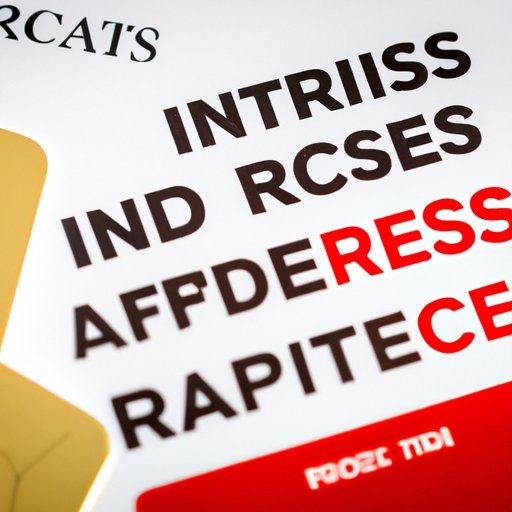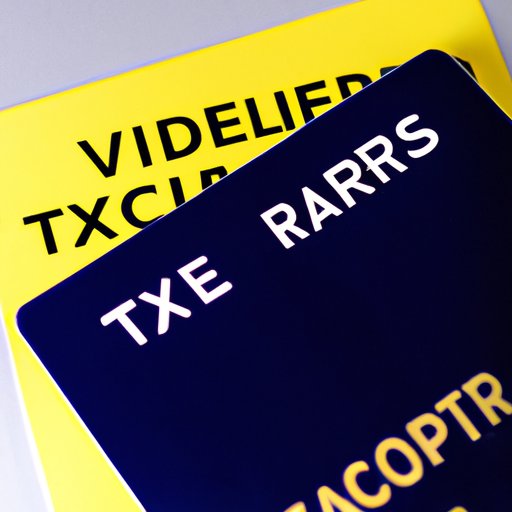
I. Introduction
Taxes are an unavoidable part of life, and paying the IRS is never pleasant. But what if you could pay your taxes with a credit card and earn rewards points in the process? Is it possible, and if so, what are the pros and cons?
In this article, we will explore everything you need to know about paying the IRS with a credit card, including how it works, which credit cards can be used, how to maximize rewards points, avoiding penalties, understanding the fees, and alternatives to paying with a credit card.
II. Everything You Need to Know About Paying the IRS with a Credit Card
Before we dive into the specifics of paying the IRS with a credit card, let’s answer the question on everyone’s mind:
A. Is it possible to pay the IRS with a credit card?
The short answer is yes, it is possible to pay the IRS with a credit card. The IRS has partnered with several payment processors that accept credit card payments for a fee.
B. What types of taxes can you pay with a credit card?
You can use a credit card to pay your individual income taxes, including any penalties and interest owed. However, you cannot use a credit card to pay business taxes.
C. Which credit cards can you use to pay the IRS?
Not all credit cards are accepted by the IRS. The payment processors authorized by the IRS only accept Visa, Mastercard, American Express, and Discover cards.
III. Maximizing Rewards Points When Paying Your Taxes with a Credit Card
One of the benefits of paying the IRS with a credit card is the potential to earn rewards points. Here’s how to maximize those rewards:
A. Overview of credit card rewards programs
Before you can maximize your rewards points, you need to understand how credit card rewards programs work. Most credit cards offer points or cash back for every dollar spent.
B. Strategies for maximizing rewards when paying taxes
The easiest way to maximize your rewards when paying taxes is to use a credit card with a generous rewards program. Look for cards that offer bonus points for spending in certain categories, such as travel or dining.
C. Examples of rewards earned by paying taxes with a credit card
Depending on the rewards program, you can earn up to 2% cash back or 2x points per dollar spent on your taxes. That translates to hundreds or even thousands of dollars in rewards.
IV. Pros and Cons of Paying the IRS with a Credit Card
As with any payment method, paying the IRS with a credit card has pros and cons:
A. Advantages of paying the IRS with a credit card
The most significant advantage of paying the IRS with a credit card is the potential to earn rewards points. Additionally, using a credit card allows you to spread out your tax payments over time, rather than paying a lump sum.
B. Disadvantages of paying the IRS with a credit card
The biggest disadvantage of paying the IRS with a credit card is the fees associated with credit card processing. Additionally, if you don’t pay off the balance in full, you’ll end up paying interest on your tax bill.
C. Comparison of paying with a credit card vs. other payment methods
Compared to other payment methods, such as a bank transfer or direct debit, paying with a credit card is more expensive due to the fees. However, it may be worth it if you can maximize rewards points.

V. Avoiding Penalties by Paying Your Taxes with a Credit Card
If you can’t afford to pay your taxes in full, you may be subject to penalties from the IRS. However, paying with a credit card can help you avoid these penalties:
A. Overview of IRS penalties
The IRS assesses penalties for failing to pay taxes on time and failing to file a tax return. The penalty for late payment is generally 0.5% of the unpaid taxes per month.
B. Explanation of how paying with a credit card can help avoid penalties
Paying your taxes with a credit card is considered a payment in full, even if you can’t pay off your credit card balance right away. As a result, you can avoid the late payment penalty while you work to pay off your credit card balance.
C. Case study of avoiding penalties by paying taxes with a credit card
For example, let’s say you owe $10,000 in taxes and can’t afford to pay it all at once. If you pay $2,500 with a credit card and accrue interest at a rate of 15% per year, you will owe an additional $150 in interest per month. However, you will not be subject to the IRS late payment penalty of $50 per month.
VI. Step-by-Step Guide to Paying Your Taxes with a Credit Card
If you’ve decided to pay your taxes with a credit card, here’s how to do it:
A. Overview of the payment process
First, you’ll need to choose a payment processor authorized by the IRS. You can find a list of authorized payment processors on the IRS website. Next, you’ll need to enter your payment information, including your credit card information and the amount you want to pay. Finally, you’ll need to review and submit your payment.
B. Detailed instructions on how to pay with a credit card
1. Visit the IRS website and select “Pay Your Tax Bill.”
2. Choose the appropriate payment processor for your situation.
3. Enter your payment information, including the type of tax you’re paying and the amount you want to pay.
4. Enter your personal and credit card information.
5. Review your payment details and submit your payment.
C. Tips for ensuring a successful payment
Be sure to double-check your payment information before submitting to avoid errors. Also, make sure you have sufficient credit available on your credit card to cover the payment.
VII. Understanding the Fees Associated with Paying the IRS with a Credit Card
As mentioned earlier, paying the IRS with a credit card comes with fees, both from the credit card issuer and the IRS. Here’s what you need to know:
A. Overview of credit card processing fees
Credit card issuers charge processing fees for credit card transactions. The fees range from 1.87% to 1.99% of the transaction amount.
B. Explanation of additional IRS fees for paying with a credit card
The IRS charges a convenience fee for processing credit card payments. For 2021, the fee is 1.96% of the payment amount, with a $3.95 minimum.
C. Comparison of fees across different credit cards
The fees charged by the credit card issuers and the IRS vary depending on the specific card and payment processor. Be sure to compare fees across different payment processors and credit cards to find the best option for your situation.
VIII. Alternatives to Paying the IRS with a Credit Card
If paying the IRS with a credit card doesn’t make sense for you, there are other payment methods to consider:
A. Overview of other payment methods
Other payment methods include a bank transfer, direct debit, money order, or check. Bank transfers and direct debits are usually free, but money orders and checks may incur fees.
B. Comparison of alternative methods to paying with a credit card
Compared to paying with a credit card, bank transfers and direct debits are less expensive, as they don’t incur processing fees. However, these methods may not offer the potential to earn rewards points.
C. Tips for choosing the best payment method
Consider your budget, timeline, and reward goals when choosing a payment method. If you need more time to pay off your taxes, a credit card may make sense. If you want to avoid fees, a bank transfer or direct debit may be a better option.
IX. Conclusion
Paying the IRS with a credit card can be a smart move if you do it right. You can earn rewards points on your taxes and avoid penalties if you can’t pay your taxes in full. However, it’s important to weigh the pros and cons before deciding on a payment method.
Remember to compare fees and rewards programs and consider your budget and timeline. Armed with this knowledge, you can make an informed decision and hopefully come out ahead.




